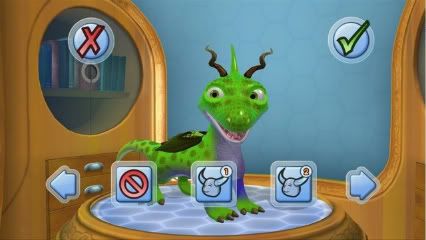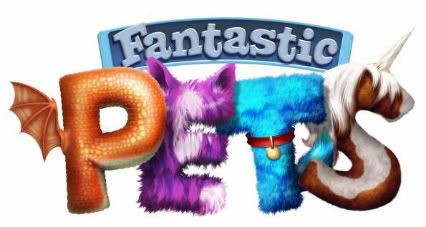When a game waves around a name like ‘Fantastic Pets’ and is advertised as “the first augmented reality game on Kinect for Xbox 360”, it’s easy to dismiss it as an EyePet clone. Broadly speaking, that’s what it is; but look closer, and you’ll see that this is no lazy copycat.
The pets are Fantastic in a fantasy sense, rather than a ‘come to life, jump out of the TV and give you a winning lottery ticket’ sense. There are dogs, cats, lizards and ponies, yes; but why have one of those when you could have, say, a dragon or a robot dog? The pet we went for was a flying unicorn. Well, we say ‘we’; Luke’s very-nearly-six year old daughter helped with the playtesting. Honest.
When you first fire the game up, it’s a very linear and controlled experience – though there’s enough variety within this half hour to prevent young players becoming bored or frustrated. What will probably hit kids first is a sense of wonder and otherworldliness; a gentle soundtrack accompanies introduction to the basics as the camera sweeps around to show a few of your potential pets and their surroundings, and explain and introduce some of the activities you can share with them.

A robot cat. A ROBOT CAT!!!
What will probably hit adults (grumpy British adults, anyway) first, however, is the initially overwhelming Americanisation; no localisation here. The narration is wonderfully done, in that it explains each button and every activity without waffling or patronising. The female narrator however sounds like she could have been swiped from any forgettable Disney high school ‘comedy’ you can think of. Not even the spellings have been changed, as you’ll see when it comes to choosing the “color” of your pet. Still, this is unlikely to bother kids yet to be taught to become pedantic bores. Like us.
Pet customisation – which is entirely optional – goes beyond choosing colors (er, colours). Though you can radically alter the pets’ appearances, some changes will affect behaviour too. Pets with horns are “more confident” and, unsurprisingly, a pet with wings can fly. You can add or delete such features for any pet, any time. What the child giveth, the child taketh away.
In a setup familiar to anybody who’s played EyePet, players can if they wish simply watch themselves on-screen, their pet in the room with them (that’s the augmented reality bit). By copying simple and easily replicated gestures, players can encourage the pet to roll over, fly, beg, and do Michael Caine impressions. Okay, maybe not that last one, but you get the idea. Much as that seems to explain THQ’s slightly odd claim that this is a great alternative to a real pet, much of the interaction takes place without the player visible.

Not, as you might think, a cruel game of croquet where you knock your pet through the hoops with a hammer.
The twelve activities to share with your pet are first introduced via the talent shows. The show arenas are disappointingly bare – but the player can often be seen in the background on giant TV screens, which is a nice touch. Each talent show is comprised of five activities with bronze, silver, and gold rosettes up for grabs in each. The more points you score, the closer you edge to the next rosette – and the closer you edge to the next Trainer level (speaking of which, there are Avatar awards to be won as you advance in rank. Heck, don’t you want a pair of horns or cat ears for your Avatar?).
Cleaning your pet is one such activity, and again is reminiscent of EyePet – rinse, wash, rinse, and dry by waving one hand about. The others are more identifiable as fun, such as the simple joy of ‘Ball Fetch’. Your pet runs up to the screen and brings you a ball, you reach out to take it, you throw the ‘ball’ and… your pet fetches it. Surprisingly fun in itself, but this is adapted for a few other games, such as one where you encourage your pet to demolish a mock city.
Other games require a more active participation. For example, another requires your pet to run around a track, sliding and then jumping at the end when prompted. Jog on the spot to get your pet moving; crouch to get your pet to sit (slide), then jump in the air for them to copy you. There are a few games where the player is on-screen. Bubble Dodge requires you to, er, dodge bubbles; or perhaps you’d prefer the gleeful violence of smashing imaginary piñatas. Careful with that one if there’s a second player. No bonus points for spilled blood or flying teeth (though it gives us an idea for the next Mortal Kombat).
 Locking content in a children’s game can seem almost perverse at times. It’s not uncommon (or unreasonable) for a child to become frustrated when they’re teased with content they can see but not access. Some elements of Fantastic Pets are locked to begin with. For example, the right to customise each pet you own, and the ability to play each of the twelve minigames outside of the talent shows, must be ‘bought’ with gems. Gems are earned within the games you play as you or your pet find and touch them, and you’ll need plenty to finally ‘buy’ everything.
Locking content in a children’s game can seem almost perverse at times. It’s not uncommon (or unreasonable) for a child to become frustrated when they’re teased with content they can see but not access. Some elements of Fantastic Pets are locked to begin with. For example, the right to customise each pet you own, and the ability to play each of the twelve minigames outside of the talent shows, must be ‘bought’ with gems. Gems are earned within the games you play as you or your pet find and touch them, and you’ll need plenty to finally ‘buy’ everything.
However, it’s unlikely that this will lead to frustration. It’s not hard to earn gems, and some will even be collected accidentally. By the time your child starts to get bored of playing the same few games, they’ll almost certainly have collected enough gems to buy their way into at least one more. Best of all, the talent shows – which feature five games at a time, including ones not yet unlocked for free play – have no entry fee.
This certainly isn’t a game to drag sociopathic teens away from the lure of killstreaks and killcam lolz. If you have children that are at all interested in the concept of virtual pets, however, they’ll love this.



















Comments